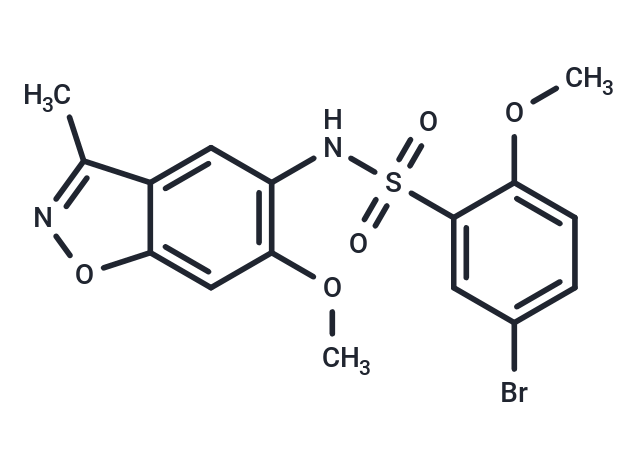Shopping Cart
- Remove All
 Your shopping cart is currently empty
Your shopping cart is currently empty

Y06036, a potent and selective BET inhibitor, can bind to the BRD4(1) bromodomain (Kd: 82 nM).

| Pack Size | Price | Availability | Quantity |
|---|---|---|---|
| 5 mg | $39 | In Stock | |
| 10 mg | $64 | In Stock | |
| 25 mg | $122 | In Stock | |
| 50 mg | $198 | In Stock | |
| 100 mg | $369 | In Stock | |
| 500 mg | $869 | In Stock | |
| 1 mL x 10 mM (in DMSO) | $43 | In Stock |
| Description | Y06036, a potent and selective BET inhibitor, can bind to the BRD4(1) bromodomain (Kd: 82 nM). |
| Targets&IC50 | BRD4(1):82 nM (Kd, cell free) |
| In vitro | Y06036 bounds to the BRD4(1) bromodomain with Kd values of 82 nM. Y06036 potently inhibited cell growth, colony formation, and the expression of AR, AR-regulated genes, and MYC in prostate cancer cell lines. |
| In vivo | The mice were randomized and intraperitoneally (i.p.) treated with either vehicle or BET inhibitor Y06036 (50 mg/kg, 5 times per week) when the tumor volume reached approximately 100 mm3. Y06036 exhibited strong antitumor activities during the 25-day treatment period, with a tumor growth inhibition (TGI) of 70%. |
| Cell Research | LNCaP, C4-2B, 22Rv1, and VCaP prostate cancer cells were cultured in RPMI 1640 with 10% FBS at 37 °C and an atmosphere of 5% CO2. For cell viability, cells were seeded in 384-well plates at 500?1000 cells per well (optimum density for growth) in a total volume of 20 μL of media. After 12 h, 10 μL of chemical compounds with 2-fold or 3-fold serial dilution was added to each well with final concentration from 5 nM to 100 μM. The measurement was conducted 96 h after seeded for LNCaP, C4-2B, and 22Rv1 and 144 h after seeded for VCaP. Then, 25 μL of CellTiter-GLO reagents was added, and luminescence was measured on GLOMAX microplate luminometer, according to the manufacturer's instructions. The estimated in vitro half-maximal inhibitory concentration (IC50) values were calculated using Prism 6 software. |
| Animal Research | Four-week-old male mice (strain: C.B-17/IcrHsd-Prkdcscid for C4-2B) were used for tumor inoculation. Each mouse was inoculated subcutaneously at the dorsal flank on both sides of the mice with C4-2B tumor cells (2 × 10^6 cells) in a mixture of 100 μL PBS and Matrigel (1:1). When the tumor volume reached approximately 100 mm3, the mice were randomized into groups (n = 5?7 per group) and then treated intraperitoneally (ip) with 100 μL of either vehicle or Y06036 and 7m (in a formulation of 15% Cremophor EL, Calbiochem, 82.5% PBS, and 2.5% DMSO) five times per week. The length (L) and width (W) of the tumor mass were monitored by calipers, and volume was expressed in mm3 calculated with the equation V = (π/6)(L × W2). Tumor growth inhibition (TGI) was calculated using the equation TGI = [1 ? (T ? T0)/(C ? C0)] × 100, wherein T and T0 are the mean tumor volumes on a specific experimental day and on the first day of treatment, respectively, for the test groups; and likewise C and C0 are the mean tumor volumes for the vehicle group. |
| Molecular Weight | 427.27 |
| Formula | C16H15BrN2O5S |
| Cas No. | 1832671-96-1 |
| Smiles | COc1cc2onc(C)c2cc1NS(=O)(=O)c1cc(Br)ccc1OC |
| Relative Density. | no data available |
| Storage | Powder: -20°C for 3 years | In solvent: -80°C for 1 year | Shipping with blue ice. | |||||||||||||||||||||||||||||||||||
| Solubility Information | DMSO: 100 mg/mL (234 mM) | |||||||||||||||||||||||||||||||||||
Solution Preparation Table | ||||||||||||||||||||||||||||||||||||
DMSO
| ||||||||||||||||||||||||||||||||||||

Copyright © 2015-2024 TargetMol Chemicals Inc. All Rights Reserved.